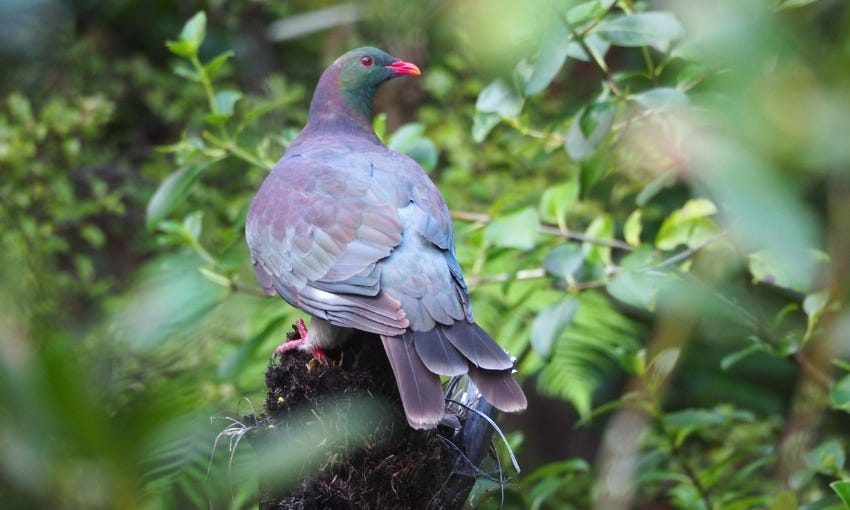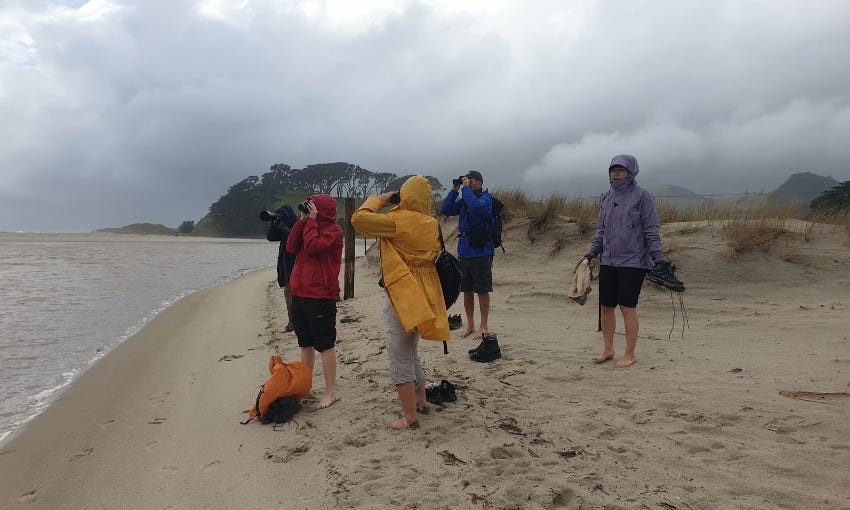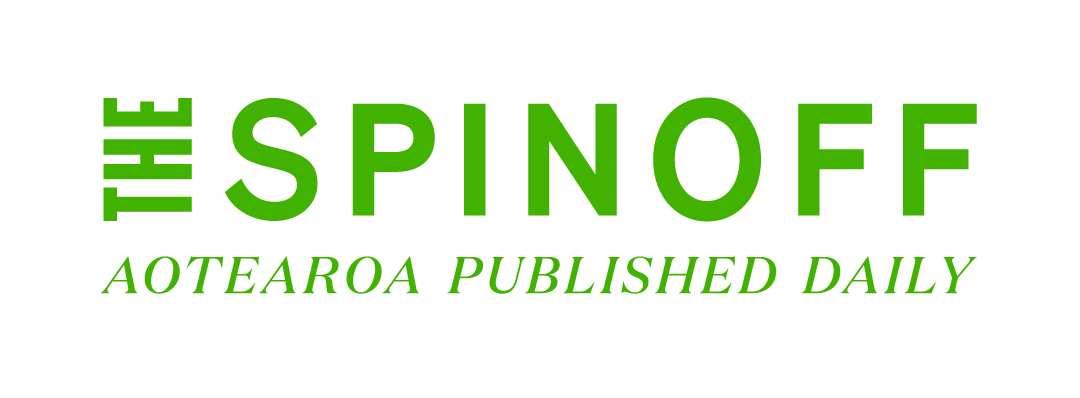On the simple joy of counting birds
How citizen science is revealing the state of our feathered friends.
Kia ora! Welcome to Future Proof. I’m Ellen, thanks for reading this week.
Backyard visitor, a kererū. Image credit: Ellen Rykers.
The annual Garden Bird Survey has begun, calling on citizen scientists across Aotearoa to count the birds in their backyard, or at their local school, park or marae. On a chilly morning earlier this week, I took a woolly blanket, a cup of hot coffee and a bird tally sheet out into the garden. I sat and watched and listened for an hour. Two kākā screeching, several tūī robot-singing, the coos of spotted doves – I was surprised by how much I heard. I scanned the greenery and spotted the beefy white singlet of a kererū. I was reminded how lovely it is to take a moment in nature – and that it doesn’t need to be big, breathtaking nature. It can just be a fantail twittering on a perch in your urban backyard.
This sense of connection – and curiosity, joy and wonder – is widely reported among survey participants, Gradon Diprose told RNZ. "It's not going to solve climate change or the biodiversity crisis, but it can help improve our immediate well-being, while taking action to monitor bird trends with thousands of other people." The Garden Bird Survey, which has been run by Manaaki Whenua since 2007, allows scientists to track how birds are faring over time. For example, the 2022 State of NZ Garden Birds report found positive signals for four iconic backyard species: kererū, tūī, tauhou (silvereye) and pīwakawaka.
The Bird Atlas
The Garden Bird Survey isn’t the only avian census mobilising bird enthusiasts: the New Zealand Bird Atlas project is cataloguing as many bird species as possible across the whole of Aotearoa. The project builds on two previous national bird mapping efforts, one in the 1970s and the other in the early 2000s. In each of these, the country is split into 3,200 10x10km grid squares and keen “atlasers” are deployed to record as many birds as possible across all four seasons. Data collection on this scale takes several years – the current iteration runs from 2019 to mid-2024 – but already is yielding valuable data on the state of our unique avian fauna, used by scientists and decision-makers alike. In a recent issue of New Zealand Geographic, Gabi Lardies joined some “bird nerds” on their counting adventures. Last weekend, I joined in briefly too, for a visit to Pakiri Beach on a squally morning. We saw variable oystercatchers, white-fronted terns, northern NZ dotterels, a banded dotterel and two shag species – a small count that will nonetheless add up into a big, birdy picture of the nation through the Atlas.
Atlasing at Pakiri Beach. Image credit: Ellen Rykers.
If you’d like to count your feathered neighbours, all the info you need is on the Garden Bird Survey website – plus, Predator Free NZ Trust has a mini-guide to help you identify some backyard visitors beyond the recognisable kererū and tūī. And if you’d like to join the ranks of intrepid atlasers, info on contributing can be found on eBird.
There’s no better time to become a Spinoff member
As we ramp up our coverage of the 2023 election, there is no better time to become a Spinoff member and support independent journalism in Aotearoa.
The financial support of our members is essential, particularly during an election. Every donation will help expand our political coverage from extra episodes of our Gone by Lunchtime podcast, to more on-the-ground reporting on the campaign trail, to more “wtf does that mean?” explainers and maybe even some election memes from editor Madeleine Chapman.
Support our coverage of the 2023 election today by becoming a Spinoff member or making a new donation.
Plastics out, food scraps in
Two excellent explainers from Shanti Mathias on The Spinoff this week. The first lays out everything you need to know about the upcoming ban on certain plastic items, which comes into effect on 1 July. Bye-bye plastic fruit stickers, and hello reusable produce bags. Single-use plastic cutlery is goneburger, while plastic straws are out (for most people).
The second explainer is on Auckland’s new food scraps system, which aims to halve the tonnage of food waste being sent to landfill by next year. On the topic of food waste, this interesting feature from the New York Times discusses South Korea’s food waste system: food scraps have been banned from landfills for 20 years, and most gets turned into animal feed, fertiliser or fuel for heating homes.
More sustainability tips for clothes-wearers
Recently I covered three simple ways to ease off the fast fashion accelerator in Future Proof. Janhavi Gosavi writes on The Spinoff about how changing her relationship with her clothes has led to a more sustainable wardrobe. “That changed once I replaced my old urge to buy new clothes with a new urge to take care of my old clothes,” she writes. “It was the clothing equivalent of feeling hungry as an adult and admitting to myself there was food at home.”
On The Guardian, the “no-wash” movement gets an airing, with some interviewees admitting they wear underpants without cleaning them for up to a week. Not sure I can get on board with wearing the same pair of undies for a week, but big yeses to washing on cold and washing other, non-underpant items less regularly!
Baby steps at global climate finance summit
“Extra firepower” to the tune of $200 billion for low-income countries is expected as a result of the recent global climate finance summit in Paris, Reuters reports. Additionally, the World Bank will pause repayments on new loans for those countries experiencing climate disasters. But the outcomes fell short of what is needed, according to activists, who point to few concrete measures that could make a difference now. Meanwhile climate change minister James Shaw has penned an op-ed alongside his Canadian and Australia counterparts calling for multilateral banks to do more for climate-vulnerable nations.
More stories:
How is New Zealand tracking against its emissions reduction plan? It’s finely balanced, Marc Daalder reports for Newsroom.
The Church of England is divesting from fossil fuels across its multibillion-pound pension and endowment funds.
This “concept farm” in Central Otago is New Zealand’s first fossil-fuel-free cherry orchard.
Auckland Council has identified 12 spots to develop “green space that every now and then will become blue space” when it floods, writes Newsroom’s Matthew Scott. (More on the power of temporary flood basins in last week’s Future Proof.)
New Zealand’s geothermal wells could permanently store carbon equivalent to taking 600,000 cars off the road.
Ancient trees on conservation land are being illegally logged and sold for profit, 1News has revealed.
Rapidly reducing fossil fuel reliance will have minimal financial impact on most people, a new study finds.
As sea levels rise and swamp the island nation of Tuvalu, will it shift its existence into the metaverse as a digital clone?
In Borneo, indigenous communities are using mapping technology to fight the encroachment of palm oil plantations onto their land.
Taxidermist Wim Spiekman looking at Delcourt’s gecko, when the specimen was brought from France to Wellington in 1990 for an exhibition. Photograph taken by Ray Pigney. Dominion Post (Newspaper): Photographic negatives and prints of the Evening Post and Dominion newspapers. Ref: EP/1990/0968/4. Alexander Turnbull Library, Wellington, New Zealand. /records/23021306
To finish this issue: ancient DNA solves the mystery of the world’s largest gecko species, Delcourt’s gecko. The extinct species is known only from a single taxidermied specimen with no label, found in the basement of a French museum in 1986. Researchers initially suggested the specimen may have been collected in New Zealand in the 19th century, and could even be the legendary kawekaweau gecko from Māori oral tradition. However, ancient DNA has now revealed the giant gecko specimen is of New Caledonian origin, not New Zealand. “This does not mean that the kawekaweau is dead in the water,” says Dr Nic Rawlence from the University of Otago. “There are large lizard bones in New Zealand’s fossil record that need genetic reassessment that could be from the kawekaweau, and newly developed non-destructive ancient DNA techniques will finally allow us to answer these questions.”
Okay, time to gecko-ing,
Ellen
Got some feedback about Future Proof or topics you’d like covered? Get in touch with me at futureproof@thespinoff.co.nz












